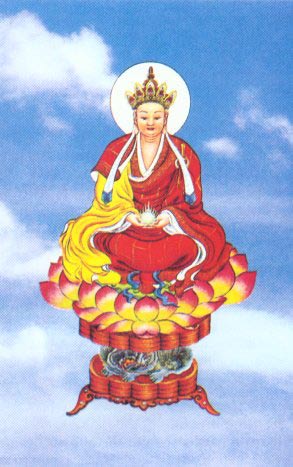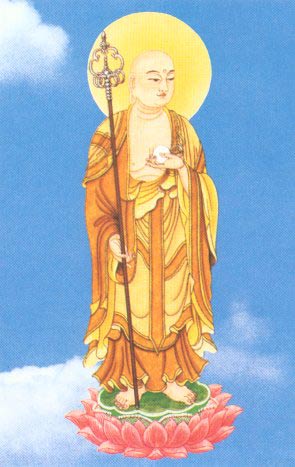
TI TSANG P'USA -- KSITIGARBHA BODHISATTVA
young maiden has since then became an accomplished
Bodhisat va through her great acts of merits and is now known
as Ti Tsang P'usa.
Ti Tsang P'usa has often been mistakened by uninformed
Buddhists to be Mogal ana who was a disciple of Sakyamuni
Buddha, because he too had a similar experience of descending
to the Hell Realm to seek and save his mother. e stories may
sound similar but they happened at different times and adopted
quite different methods to save their mothers.
Many others also tend to relate Ti Tsang as the Hsuan Tsang,
the famous Tripitaka master of the Tang Dynasty who made the
harzadous journey to the West to seek the Buddhist scriptures.
is is mainly due to the Sangha robe and the five-leaf crown
which both are seen to wear.
As the "Regent of Hel " Ti Tsang P'usa is again taken by many
to be "Yen-Lo-Wang" or Yama, the "OverLord of Hel ". It must
be mentioned that Ti Tsang is a Bodhisat va and not a mere
King of the Fifth Hel . He does not judge the souls of the dead
but seeks to save them from the punishment inflicted on them
by the Kings of Hel .
escription of i sang 'usa
Ti Tsang may be represented sit ing or standing. He always has
a kind and benevolent look and carrying either, or both, his
symbols of the Cintamani or "Wish-fulfil ing Jewel" and the
"Ringed-Staff", which is also cal ed the Khakkhara. is ringed
staff is often carried by Buddhist monks in their travels so that
the sounds caused by the jingling rings can warn small animals
and insects of their approach lest they be trod upon and kil ed.
It is also sometimes cal ed the alarm-staff.
In the above much treasured picture of Ti Tsang P'usa, which
is found in many Buddhist homes and temples, he is seen seated
upon a lotus throne. His hands holds the precious flaming pearl
which has vast magical powers beyond description. He wears
the robe of a Northern Buddhist monk and on his head is the
"five-leave crown, where the representation of a Dhyani-Buddha
can be seen on each of the leaves."
Whenever you have the urge to pray to this Bodhisat va for any
help, look at this picture intently for a few seconds as you silently
recite, "NAMO TI TSANG WANG P'USA, NAMO TI TSANG WANG
P'USA...,' before closing your eyes to visualise him. Ti Tsang
P'usa is very responsive to sincere prayers of faith and he may
yet grant you your wish, if it is not too unselfish or unreason-
able. All may pray to him with this simple invocation and, who
knows, your past karmic links with him may yet make you into
another ardent Ti Tsang devotee again in this lifetime.
e standing posture of Ti Tsang is particularly popular in Japan
where he is known as Jizo Bosatsu. It represents the readiness of
Jizo to respond immediately to the cal s of help made by those
who have faith in his saving powers. Standing upon a lotus, he
holds his precious flaming jewel with his left hand while the
ringed staff is held with the right, ever ready to force open the
gates of Hell with the staff and to dispel the darkness of the in-
fernal realm with his luminous gem.
Ti Tsang is at times depicted accompanied by a dog which also
has a significant meaning. On the death of his mother, the Bodhi-
sat va, known as "Sacred Girl", hastened into the underworld with
the view of comforting her and to seek for favourable treatment.
However he could not find her whereabouts but later discovered
that she had already taken rebirth as a female dog. Upon his re-
turn to earth Ti Tsang soon traced and adopted the animal which
henceforth became his close companion on his pilgrimages.
Another popular depiction of him is in this standing or `activity-
form' which has his left hand holding an alms bowl against his
navel, while his right hand forms the mudra (hand-sign) of "giv-
ing consolation and peace to all living beings".
Ti Tsang P'usa has many emanations and he has manifested in
countless forms to save beings at different times and places. In
the Chinese Buddhist Pantheon his is the only figure in the
form of a monk. is is to indicate that Mahayana Buddhism is
suitable for both the monks and the laity.
Ti Tsang's compassion is not practised exclusively for the benefit
of the beings of the hell realm, he also gives blessings to those
of the world who seek his help and he is a comforter of the poor,
oppressed, sick, hungry, and those who are troubled by spirits
and nightmares. ose who have firm faith in him can easily
receive his protection. With faith one need to recite any of these
simple prayers:
"NAMO TI TSANG WANG P'USA" or
"NAMO KSITIGARBHA BODHISATTVA YA".
Images of the Buddhas and Bodhisat vas are recognised by the
symbols that they are associated with. Each of these symbols
have significant meanings which most people are unaware of.
e Khakkhara, or Ringed Staff, which Ti Tsang holds is not
only meant to warn small and crawling creatures of his approach
so as to avoid stepping on them but also to inform people of his
presence through the jingling caused by the rings. Often a trav-
el ing monk on a pilgrimage has to stop at homes to seek alms
and since he does not wish to speak unnecessarily, he usual y an-
nounces his arrival by shaking his sounding staff.
e Khakkhara is often a wooden staff capped with metal loops
or crotchets and rings which are either four, six or twelve in
number. e Four-ringed staff is carried by a monk who has
perceived the Four Noble Truths of Suffering, the Cause of Suf-
fering, the Cessation of Suffering, and the Path leading to the
Cessation of Suffering. e Six-ringed staff belongs to a Bodhi-
sat va who is constantly practising the Six Paramitas, while the
Twelved-ringed staff is held by a Pratyeka Buddha who has real-
ised the Twelve-fold Links of Causation.
As a result of Ti Tsang P'usa having made this promise to
Sakyamuni Buddha: "I will fulfil your instructions to continue

TI TSANG P'USA
to relieve beings from their states of suffering and lead them
to Salvation. I shall strive to work hard until the next Buddha,
Maitreya Buddha, comes to the world." He is also adored as the
"Master of the Six Worlds of Desire," thus there are depictions
of him being surrounded by a Bodhisat va, an Asura, a Man, an
Animal (horse or ox), a Preta, and a Demon holding a pitchfork,
which symbolises the six different forms he assumes in the six
realms to save the beings there.
In the closing chapter of the Ti Tsang Sutra, Sakyamuni Buddha
gave this advice for the benefit of all human beings:
"Listen to me careful y and I shall tell you in detail. If virtuous
ones of the future see the Ksitigarbha Bodhisat va's image, hear
the Ksitigarbha Sutra, chant this Sutra, make offerings to Ksiti-
grabha, pay homage to him, they will receive these benefits:
1. ey will be protected by devas and dragons.
2. eir ability to do good will be increased.
3. Opportunities for doing good will increase.
4. ey will strive to attain Buddhahood.
5. ey will enjoy sufficiency of food and clothing.
6. ey will be free from diseases.
7. Floods and fire will not affect them.
8. Robbers will not trouble them.
9. ey will be respected and admired by people.
10. Spirits and devas will protect and assist them.
11. Females shall be reborn as males.
12. e females wil become daughters of noble & exalted families.
13. ey will be reborn with good complexion.
14. ey will be reborn in the heavens for many lives.
15. ey will be reborn as kings or rulers of countries.
16. ey will have wisdom to recol ect their past lives.
17. ey will be successful in all their aspirations.
18. ey will enjoy happy family relationships.
19. Disasters will not affect them.
20. eir bad karma will be removed.
21. Wherever they go, they are safe.
22. ey shall always have peaceful dreams.
23. eir deceased relatives shall be free from sufferings.
24. ey will be reborn with happiness.
25. ey will be praised by divine beings.
26. ey will be intel igent and skilful.
27. ey will have compassion for others.
28. ey will final y attain Buddhahood.
e birthday of Ti Tsang P'usa fal s on the 30th day of the 7th
moon of the lunar calendar which coincides with the very day
when the gates of Hell closes to mark the end of the Festival
of the Hungry Ghosts. All over the world Buddhist Temples
offer prayers to Ti Tsang P'usa during this yearly Festival for the
benefit of the dead.
Ti Tsang's popularity among the Chinese and Japanese Buddhists
is second only to Kuan Shih Yin P'usa as he takes upon himself
the fearful and distasteful task of bringing relief and consolation
to suffering beings of hel .
¡ûBACK¡û |INDEX| ¡úNEXT¡ú